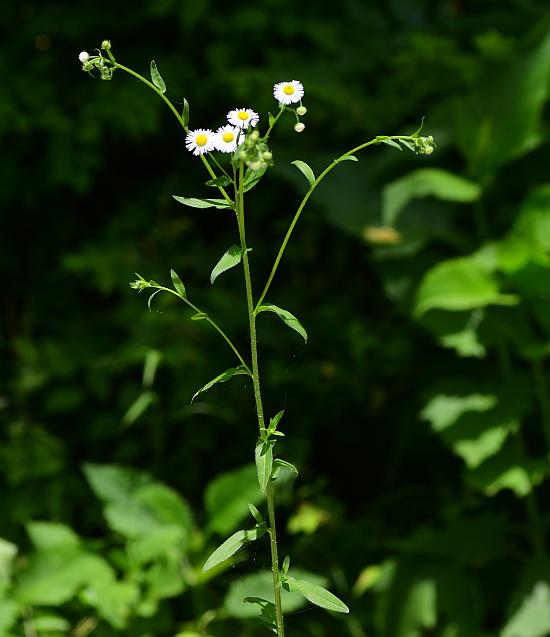Erigeron annuus (L.) Pers.
Daisy Fleabane

Native
CC = 1
CW = 3
MOC = 83
© SRTurner
Erigeron annuus (L.) Pers.Daisy Fleabane | |
 |
Native CC = 1 CW = 3 MOC = 83 |
© SRTurner |
|
Family - Asteraceae/Astereae Habit - Annual or less commonly biennial forb, with shallow, fibrous roots. Stems - Ascending to erect, to 1.5 m, sometimes multiple from base, usually well branched above the lower 1/3, often ridged, sparsely to densely roughened with mostly spreading hairs (the hairs sometimes more appressed toward the tip).
Leaves - Alternate and basal, simple. Basal leaves sometimes withered by flowering time, 3-15 cm long, mostly long-petiolate, the blade broadly oblanceolate to broadly obovate, short- to long-tapered at the base, mostly rounded at the tip, the margins coarsely and sharply toothed, the surfaces and margins sparsely to moderately pubescent with short, relatively stiff, curved hairs. Stem leaves usually relatively numerous, 1-10 cm long, the lower ones short-petiolate, the median and upper ones sessile, the blade oblanceolate to elliptic or lanceolate, angled or tapered to a mostly sharply pointed tip, angled, tapered, or narrowly rounded at the base, not or only very slightly clasping the stem, the margins of all but the uppermost leaves usually with several sharp teeth on each side, these often produced from below the midpoint to the tip, the surfaces and margins sparsely to moderately hairy.
Inflorescences - rounded to more or less flat-topped panicles, usually open and often with numerous heads.
Heads - Involucre 3-5 mm long, the receptacle 6-12 mm in diameter at flowering, the bracts sparsely to moderately pubescent with more or less spreading hairs and often also minutely glandular.
Flowers - Ray florets 80-125 per head, pistillate, the corollas 4-10 mm long, white or sometimes tinged with pink. Disc florets numerous, perfect, the corollas 1.5-2.5 mm long, yellow. Pappus of the ray and disc florets of 2 types, an inner series of 10-15 threadlike bristles 1.2-2.2 mm long and an outer series of several shorter bristles or slender scales 0.1-0.4 mm long, the ray florets lacking the longer, inner series.
Fruits - Achenes 0.8-1.0 mm long, flattened, the angles usually with thickened nerves or ribs, sparsely and inconspicuously hairy. Flowering - May - November. Habitat - Streambanks, pond margins, forest openings, prairies, pastures, fields, railroads, roadsides, open, disturbed areas. Origin - Native to the U.S. Lookalikes - Other species of Erigeron. More broadly, Leucanthemum vulgare. Other info. - This is a very common plant in Missouri, occurring statewide and also across most of the eastern half of the continental U.S. It is recognized by the large number of white ray florets in its flowering heads and leaves which are mostly sessile but not clasping the stem. Leaves on the lower stem usually have a few teeth toward their tips, though this character is somewhat variable. The leaves are wider than those of E. strigosus. Photographs taken in the Ozark Scenic Riverways, 6-3-03 (DETenaglia); also at Weldon Spring Conservation Area, St. Charles County, MO, 5-20-2007, and along the Katy Trail near Marthasville, Warren County, MO, 6-5-2022 (SRTurner). |